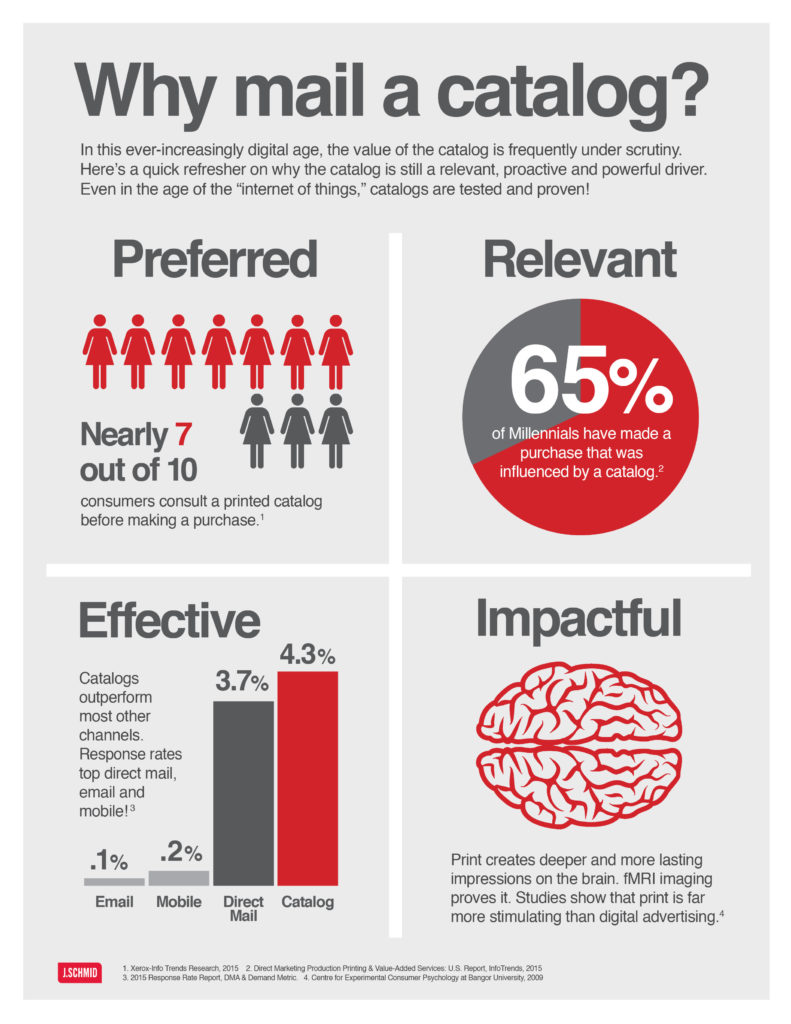
Image source: jschmid.com
The results are in, and Harvard Business Review has something to say about the state of catalogs in the 2020 marketing strategy.
“Despite two decades of email and social media marketing, and the digitization of the consumer experience, catalog mailings have been steadily increasing since 2015,” writes Jonathan Z. Zhang in Harvard Business Review. “What’s more is that consumers are surprisingly enthusiastic about receiving them – response rates from catalogs have increased by 170% from 2004 to 2018. The effects are not just confined to digital laggards who do not go online – in fact, there’s evidence that Millennials are particularly interested in catalogs they receive in the mail.”
It’s official, folks … catalogs are making a comeback in a big way.
Just look at retailers like Nordstrom, Patagonia, Crate and Barrel and Restoration Hardware that are, as Zhang notes, “investing heavily in physical catalogs. Even pure-online retailers that prided themselves in creating efficient and digitized consumer experiences such as Wayfair, Bonobos, Birchbox, and Amazon are now printing catalogs.”
The folks at HBR aren’t just getting their facts from market research and industry stats (although those sources would confirm these findings.) They partnered with a U.S.-based luxury watches and jewelry brand that sells exclusively online.
“The company acquires new customers through online search and other online platforms, so all customers are comfortable with e-commerce and digital communication. More than 75% of the company’s revenue comes from repeat purchases, and so and relationship development efforts are critical,” Zhang explains. “When a customer’s first order ships, the company obtains permissions for future marketing contacts, then uses weekly email marketing campaigns to promote repeat purchases.”
All of their marketing had, to this point, been digital. And it’s working – the company reports annual revenues of $60 million and a database of 28,000 customers.
For this study, the company launched a high-quality bi-monthly catalog campaign. Using a random 30% of their customer base, 5% received no emails or catalogs for six months; 55% received weekly marketing emails; and 40% received the new catalogs plus weekly email marketing.
The results?
Compared to the “email only” group, “email + catalog” showed a 15% life in sales and a 27% lift in inquiries, proving that adding a print catalog to an existing email campaign absolutely drives new sales.
“The sales and inquiry lifts from catalogs almost doubled those from email marketing,” Zhang notes. “Furthermore, of those customers that received the catalogs and also made product inquiries, surveys by the company’s staff found that over 90% of the customers have browsed through the catalogs and kept them for an average of seven days. The open rate was much higher than that of the email campaign which was around 26%. During the six-month experimental period, customers in the email only group purchased an average of 0.3 additional products.”
Beyond the stats, consumer response was eye-opening. When asked “how easy it for you to imagine wearing the product?” the people in the email-only group gave an average rating of 4.3 (out of 7); the email + catalog group averaged a 5.6 rating.
“These results provide evidence that catalogs can increase sales and consumer engagements through enhanced product vividness and the ease of product imagination,” Zhang notes.
The take-away on all of this? If your digital marketing is working, great. If you want it to work even better, add print catalogs to the mix.
